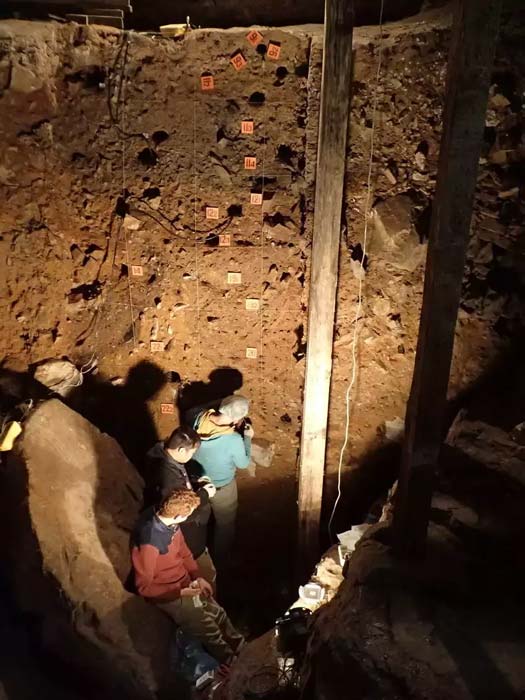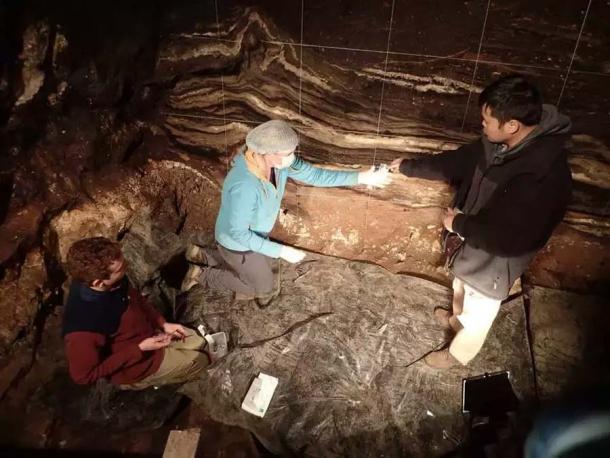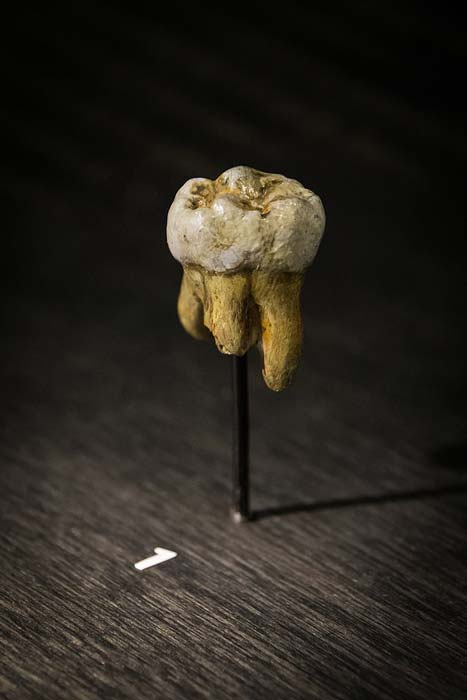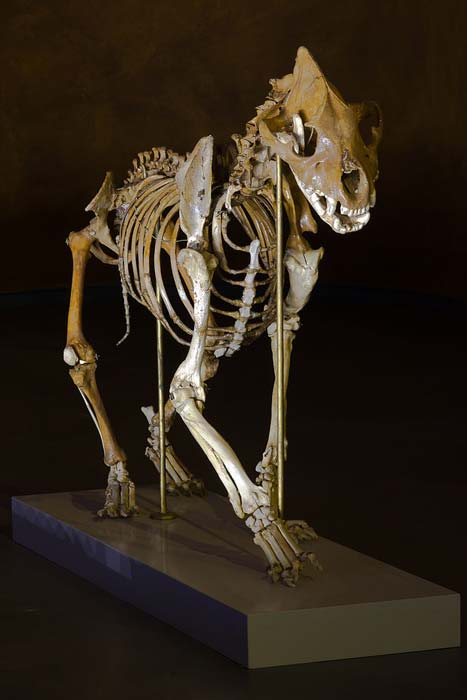
Denisova Cave DNA: Neanderthals, Denisovans and Humans Lived Together!
The deeply-ancient Denisova Cave in Siberia was at times home to Neanderthals, Denisovans and modern humans “at the same time” based on the latest Denisova Cave DNA research.
Nobody in the world had expected first-contact to come from a tiny, fossilized pinkie bone, but 10 years ago it was the discovery of such a bone that introduced us to the hitherto unknown and now extinct "Denisovans.
A new study of Denisova Cave DNA sampled from the floor of the Russian cave has revealed for the first time that the cave was also used by modern humans. But what was completely unexpected is that the new dating suggests the ancestors of modern humans lived “alongside Denisovans and Neanderthals.”

Researchers Zenobia Jacobs, Bo Li and Kieran O'Gorman collecting soil samples in the main chamber to test for Denisova Cave DNA. (Professor Richard G. Roberts / University of Wollongong)
Denisova Cave DNA Changes Everything And Proves More
“Aju-Tasch” is more famously known as the “Denisova Cave,” and this time capsule of anthropological treasures was found hidden in a cliff face in the Anui River valley in the Altai Mountains of Russia. The cave comprises 20 layers of excavated artifacts indicating occupation by hominins as long ago as 280,000 years before the present, and signs of habitation have been found all the way into the Middle Ages.
- 45,000-year-old Cave Lion Figurine Uncovered At Denisova Cave
- Denisovan DNA in Tibetan Cave Changes History of Early Humans in Asia
Up until recently, according to Britannica encyclopedia, researchers have suspected that the cave was inhabited by early modern humans ( Homo sapiens) and Neanderthals ( H. neanderthalensis). However, evidence of a previously unknown group of hominins, the Denisovans, who were neither modern humans nor Neanderthals, was also discovered at the site.

Researchers Zenobia Jacobs, Bo Li and Kieran O'Gorman in the south chamber of the cave taking sediment samples as they search for more Denisova Cave DNA. (Professor Richard G. Roberts / University of Wollongong)
Scraping Hominin DNA From Prehistoric Soils
The new research was published in the Nature journal and covered as well in a release from the Max Planck Institute. The research study’s lead author, Dr Elena Zavala, a graduate student at the Max Planck Institute for Evolutionary Anthropology, and her colleagues worked with a team of Russian DNA researchers. The primary goal was to test the soil floor of the three-chamber cave to try and gain a clearer picture of how and when modern humans, Neanderthals and Denisovans lived in the now famous Denisova Cave.
For four decades researchers have been studying artifacts and DNA gathered from soils within the cave. However, according to an article about the new research in Science Mag, only over the last 4 years has anyone found DNA from extinct humans in the ancient cave soil.

A Denisovan tooth found in Russia’s famous Denisova Cave in 2000. (Thilo Parg / CC BY-SA 3.0)
Decompressing The Habitation Layers
Previous research highlighted in this Science Mag article stated that “728 soil samples” had been taken in the cave. And now, after almost 24 months, the researchers have published new research about their discovery of “human DNA in 175 of the samples.”
An article about the paper published by the Max Planck Institute quotes Dr Katerina Douka, an archaeological scientist at the institute who said the new study represents the “largest and most systematic of its kind.”
- Finger Bone Points the Way to Revealing Denisovan DNA Secrets
- A Trove of New Denisovan Discoveries Revealed At A Recent Anthropological Conference
The study concludes that the three different groups “moved in and out of the cave over time.” However, Dr Zavala’s work confirms that Denisovans were the cave ’s first inhabitants about 300,000 years ago and that they disappeared 130,000 years ago. A different group of Denisovans who “likely made many of the stone tools,” then moved into the cave shelter about 30,000 years later. It would be 170,000 years after the first inhabitants that Neanderthals used the cave, at times, “overlapping with the Denisovans,” and the first humans used the cave beginning around 45,000 years ago.

A reconstructed fossil skeleton of a cave hyena (Crocuta crocuta spelaea). Cave hyena bones were also found in the Denisova Cave, and this must have resulted in horrible attacks on the hominins living there. (Muséum de Toulouse / CC BY-SA 3.0)
Even Man Eaters Loved The Denisova Cave!
DNA is like any organic matter, and it has a shelf life dependent on the environment in which it found. The Denisova Cave DNA covered all three human groups, and the researchers wrote in their paper that the time periods represented by each soil layer “are quite large.” According to Dr Zavala, this is the first time archaeologists have discovered an ancient site where Homo sapiens, Neanderthals and Denisovans “lived together through time.”
The fossils of many ancient animals were also discovered in the cave which corresponded with times the climate became cooler. Over time, many different species of hyenas and bears use the cave to shelter from the harsh Russian winters, and it was for this reason it is known locally in Altay as “ Aju-Tasch” or “bear rock.”
Top image: The entrance to the Denisova cave in the Altai Mountains of Siberia where the so-called new “Denisova Cave DNA” has proven, for the first time, the Neanderthals, Denisovans and Homo sapiens occupied the same cave at the same time sometimes! Source: Professor Richard G. Roberts / University of Wollongong
By Ashley Cowie

















Comments
Enjoy reading your articles. Have a question: dna tests show my having 4% Denisovan and 3% the much later Neanderthals. Should I be happy or sad?